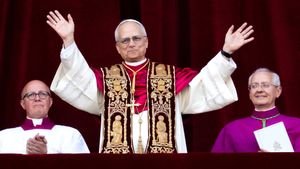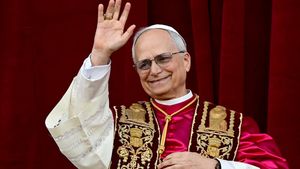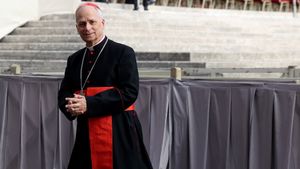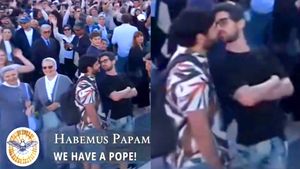I meet Elegance Bratton at a Starbucks on the corner of Christopher Street and Seventh Avenue, a hundred feet from the Stonewall Inn, where Marsha P. Johnson and Sylvia Rivera, two trans women of color, helped start the LGBT liberation movement.
Dressed in a wool coat and sunglasses that seem to have never left his face, Elegance speaks in a high, confident, almost Valley girl-ish tone. He is as fabulous as Christopher Street once was. That's because Elegance came of age on Christopher Street, had sex for the first time with another man there, and now makes art there. His upcoming documentary, Pier Kids, documents how this street is still crucial for queer youth.
I grew up a few blocks from Christopher Street, and though I was never in the scene (I was too white, and too young to have been a part of its heyday), I deeply appreciated growing up on its periphery. After our insipid Starbucks coffee, I suggest to Elegance that we take a walk along the seven blocks of Christopher Street, not much more than half a mile, to figure out what happened here. I knew that to those who pass through, to the tourists holding phones close to their faces in order to figure out which avenue they're standing on, to the business-casual set on their way from their offices to Le Pain Quotidien, this could be any typical New York street, packed with restaurants and people and stores of every kind.
But to me it seems both banal and bizarre. Like Elegance, I'd known a previous era of Christopher Street, and this new sea of pedestrians doing nothing but consuming makes me sad. What happened to its queer scene? Of course, for those who relied on Christopher Street as a safe space -- the mostly black and Latino gay, lesbian, trans, and queer youth -- the stakes of this transformation from a space of celebration to one of consumption have been much higher. I stand there and wonder, in the year of a Donald Trump victory and the massacre of 49 members of the queer community at an Orlando club, what does it mean that this street no longer feels like a queer haven? The queens and the voguers and the butch lesbians who had helped me figure out who I was, who had become a ragtag family to Elegance from the time he was a teen, have moved on.
It feels not only like change but like loss. To understand why Christopher Street was and is important, one must first understand what happened here, how a space so crucial to the identity and safety of so many could slowly vanish. So Elegance and I walk.
**
Elegance, now 37, grew up a 40-minute train ride away in New Jersey. He knew he was gay early in his life, and -- facing rejection by his family -- headed to Christopher Street one evening at the age of 16, following three men he saw voguing on the commuter rail from Jersey until he found himself among dozens of people who made him feel at home for the first time. That night, Elegance was cruised by a man with, as he recalls, "light brown skin, curly hair, greenish eyes, and big hands." By the end of the night, the two were hooking up on the far end of the concrete pier that juts out into the Hudson River. The skyline of Jersey across the river played background to Elegance's first night of real romance.
The more confident Elegance became in his sexuality, the less welcome he felt in his mother's home, until New Jersey was entirely out of the picture. He ended up homeless, crashing on couches, in beds, in the dorm rooms of NYU kids. That was his life for 10 years -- with no permanent home but Christopher Street.
Elegance was like a lot of kids out there; 40% of homeless youth identify as LGBT. The majority of those kids, like Elegance, were forced out or ran away from home. And in New York, until recently, Christopher Street was the place to go when that happened. There were other options, of course -- nonprofits that provided services, homeless shelters where one could sleep -- but Christopher was the place queer kids went to feel accepted and loved.

"I was just drawn to it," Elegance says. "I was addicted to seeing people who looked like me, who were gay. At home, people didn't even know I was gay. On Christopher Street, not only did they know I was gay, they knew how I wanted to have sex. They knew all this stuff about me that I couldn't even admit to myself out loud."
As we walk down Christopher Street toward the pier, Elegance paraphrases a quote from a theologian named John O'Donohue: Home is where you feel most understood. For Elegance, and thousands more, Christopher was the only place where it was possible to feel that.
The street, especially for people of color, was the safest space they could find. But it always came with risks: Marsha P. Johnson, the black trans activist who helped kick off the Stonewall riots, ended up dead in the water at the end of the Christopher Street pier in 1992. Police ruled it a suicide, but friends suspected she'd been murdered. Harassment from neighbors and police was ever-present. But over the past 20 years, it seems to have gotten worse.
In 1998, the state signed away partial control of Hudson River Park -- i.e., the piers -- to an organization funded with private dollars from the owners of the high-end buildings that surround the pier, which lines nearly the entire west side of Manhattan. Christina Hanhardt, a professor of American studies at the University of Maryland and the author of Safe Space: Gay Neighborhood History and the Politics of Violence, argues that's when gentrification was kicked into overdrive. The privatization of the pier meant real estate owners began to see race and class as threats to their property values. And so the pier got new grass, new pavement, playgrounds, gates, locks, increased police presence, and a curfew.
Public bathrooms began shutting down earlier. The medical vans that served the LGBT youth were suddenly required to secure a $25,000 permit to operate, and the nonprofit FIERCE documented a rise in police harassment and brutality against the LGBT youth who hung out on Christopher Street, especially at the now partially privatized pier.
The mostly white residents of the West Village were never very sympathetic to the mostly black and Latino queer scene, but in the 2000s, tensions rose. The local press documented an increase in residents complaining about the noise, the fights, and the violence that would break out at night. The owners of bars mostly frequented by white gay men began to complain too, saying their business was being hurt by the rowdiness outside. Chi Chiz, the last Christopher Street bar left that felt like a welcoming space to Elegance and many others, closed in 2010 after being sued by the city for allegedly allowing people to sell drugs on its property. Chi Chiz was not alone: In the 2000s, several bars and clubs closed, some the victims of police raids, and others of ever-increasing rents. But for black and Latino queers on Christopher Street, the closure of Chi Chiz felt particularly troubling.
"I felt like it was a line in the sand. It was very clear what was going to happen next," Elegance says as we pass the space once occupied by the bar (it's now a sushi place). "When I walk through here, I have a range of emotions for this space. What can you do with the will of the rich in a city obsessed with money? What can you really do except just persist to be present and hope that eventually these rich people will find somewhere else to go?"
Police, residents, and those frequenting Christopher Street have butted heads for decades, but this decade has seen the addition of countless hookup apps that provide a safe space for meet-ups away from the prying eyes of the public and the police.
And so with more police, more fences, and more apps, Christopher Street's queer scene became more isolated, more dispersed, more private, pushed to the edges of the neighborhood and out of it entirely, its culture flipped so that the norm of 10 years ago -- black and Latino kids proudly parading down the block -- is now the oddity, the thing to be gawked at from behind a window over a glass of wine at a French restaurant.
**
On a Friday night I walk down Christopher Street alone. The pier is relatively desolate, except for a few joggers, a cop car, and two people huddled on a bench. Nay B. and Rudy Jimenez, both in their early 20s, are friends from high school, and both started coming here about eight years ago. Nay knew by the time he was taking the train down from the Bronx that Christopher Street was long past its heyday -- not "dicks galore," as he puts it -- but he also knew it was the only place where he could find "freedom, solace, and community." He and Rudy said they're ambivalent about the police presence, as Christopher Street does get violent, but just hope it doesn't get cleaned up too much; otherwise it will become all joggers and tourists and be as boring as midtown.
Up the block, on the corner of Hudson Street, Bianka Van Kartier, a neighborhood regular who remembers everyone's face, stops at the pizza place on the corner to help the young guy working behind the counter with his English assignment. The policing has eased up under Mayor Bill de Blasio, she says. It was worse under Bloomberg. "I remember the crowds, the loudness, the loudness of the fashion," she says. "We're a long way from that."
I walk a few blocks up, past two fancy dog stores, past a velvet-roped line outside Stonewall, past groups of carefree tourists. And I wonder what can be garnered from being here now. This place, even though I was only a tangential witness to it, was crucial in forming my identity, in helping me understand who I was. It feels, to put it bluntly, less crucial these days.
I know police and real estate prices can't be to blame for all of this -- there's a bevy of apps on my phone that provide the same basic function public spaces and gay bars once did for queer people. I know that even if Christopher Street were still thriving, I might be at home staring at Grindr instead. But Grindr doesn't explain why there's a healthy (mostly white) queer scene in Brooklyn and a dozen gay bars in Hell's Kitchen. Most of the scene in New York hasn't vanished; it's just shifted. Still, especially for people of color, there doesn't seem to be a central location to meet and be seen.
"There used to be a specific region of a city you could go to. We don't have that anymore," says Dion McKenzie, a DJ from Jamaica, Queens, who goes by the name TYGAPAW and usually plays venues in the outer boroughs. Now she has to search out venues and clubs willing to host her and throw themed nights. There's little sense of permanence.
I end my night on the corner of Seventh Avenue and Christopher Street, the heart of this place, where an NYPD floodlight is erected most weekends, casting a bright whiteness over the entire corner. The light is off this weekend for whatever reason, and so the street is dark except for the flashes of a police cruiser looping the block over and over again. On one pass, an officer leans out of his window and tells a group of young people under some scaffolding to move along.
A young man, Deshaun Marie, hangs out near the subway stop there with his friends. The group has been chatting for about an hour, when a drunk man, holding on to the shoulder of a friend, stumbles through them, asking if they sell weed. They say no. Then Deshaun says he's bored and leaves to go home to the Bronx to watch Netflix.
Like what you see here? Subscribe and be the first to receive the latest issue of Out. Subscribe to print here and receive a complimentary digital subscription.


























































































